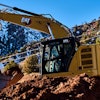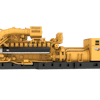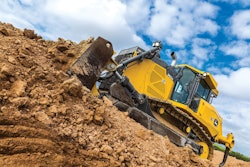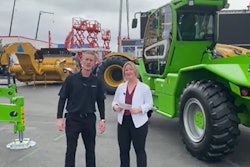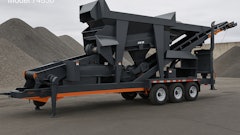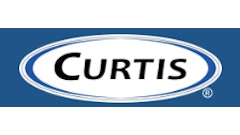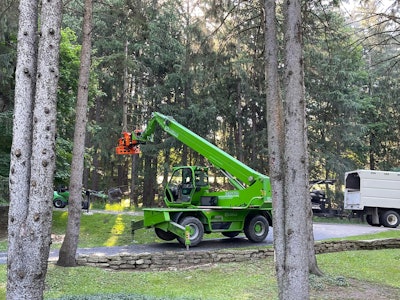
Ben Morton, a contractor and owner of Ben Morton Builder who does residential construction along Maine’s coast – notes that material management and handling is the most expensive factor in residential construction.
To that end, he’s a big fan of the diverse functions of rotating telehandlers. He has two Manitou rotating telehandlers and one traditional telehandler in his fleet.
“Anything I can do to make materials management more efficient is a big win for me,” Morton says. “Getting into a rotating telehandler has the benefit of being three machines in one. Not only does it move materials with forks like a regular telehandler, but it works equally as a crane and also as a man basket.”
That enables the operator to secure and offload the materials while maintaining control of the machine, he adds.
The ability to position the machine in a static spot and rotate 360 degrees, easily switch out attachments, and operate with a wide variety of attachments makes the machines extremely versatile for jobsites of all shapes and sizes, says Steve Kiskunas, Manitou Group product manager.
“When compared to a traditional telescopic handler, it can take the driving aspect out of the equation when moving material. Minimized movements around jobsites helps reduce the number of moving vehicles and machines around workers. This is a major product advantage on tight urban jobsites where space to maneuver the machine is limited,” he adds.
Addressing the user-friendliness of his fleet’s rotating telehandlers, Morton notes he started off with an older one that took quite a bit to figure out how to use it.
“When I got the new one, I understood the platform,” he says. “The new one was a breeze. When one is set up on outriggers, I can teach one of my guys to use the remote in a matter of minutes. In getting them familiar with the entire machine, it definitely takes a few days to a week in in terms of understanding how to set it up.
“You have to know to use it properly. It's not like a regular forklift. You would not want to rent one just for the day. It has a longer learning curve than a normal forklift.”
Morton says he chose Manitou equipment for the interchangeable attachments.
“It’s a huge benefit,” he says.
For example, the forks go on all three machines.
“You need to make sure the plate on the attachment mast is in the system for the machine,” he says. “The machine has to be technically rated for the attachments, which they all aren't.”
While Morton is saving costs investing in one piece of equipment that performs multiple functions, he’s also saving on labor costs, he notes.
“I’m not going to say it replaces people, because my company has actually gotten bigger since I've gotten the machines,” he says. “But it allows the people that I have to be optimized. Instead of just burying materials around, their focus is on cutting and installing materials properly.
“They’re not tired in our store at the end of the day. They're able to focus all their energy into creating instead of carrying stuff. Since I’ve gotten the machines, it’s been nothing but great. To determine the value, you’d have to set up a stopwatch and time how long it takes a guy to carry 50 sheets up to the second floor versus the machine doing it in a minute and then multiply that by how much you're paying the guy per hour.”
Morton says he avails himself of training offered by the National Commission for the Certification of Crane Operators (NCCCO) specific to telehandlers.
“That is phenomenal because for me, I had to get trained in all three: a forklift certification, a Mobile Elevating Work Platform certification, and crane certified. The NCCCO, which does the crane certification, just came out with a three-in-one course.
“The crane course was almost prohibitively expensive, long and difficult for a carpenter. I’m not a dedicated crane operator – I’m just a guy who operates the machine of the crane occasionally. But the new course combines all three, simplifies them and is making it easier to get certified on these.”
Manitou offers a full line of rotating telehandlers with varying sizes, operating ranges and engine types, including two electric models that run with zero emissions, low noise and reduced total cost of ownership.
Maximum capacities reach as high as 15,432 pounds with height reaches up to 113 feet and 10 inches, and a reach of 91 feet and 10 inches.
Manitou MRT Vision Plus telehandlers are designed to be powerful, safe, precise, stable and versatile handling solutions offering optimal visibility through a panoramic cab with machine accessibility from four sides.
The machines feature a large, ultra-intuitive touch screen that works even while wearing gloves. The pressurized cab is designed for a healthy working environment and additional sound insulation.
Each rotating telehandler functions as a telescopic material handler, suspended load handler, and an aerial work platform with a number of compatible attachments, including forks, man baskets, and jib and winch systems.
“With complete 360-degree rotation of the turret, most of the required operations can be executed easily without needing to move the machine,” Kiskunas notes.
The MRT Vision Plus also is equipped with a new radio remote control with integrated display.
“We’re seeing this as extremely beneficial with operators who prefer to work at or near the place where a load is being picked or placed versus viewing it from the cab,” says Kiskunas. “This also makes it even easier for the operator to communicate with their co-workers on the ground.”
Each rotating telehandler is equipped with audible and visual indicators informing the operator in case of overloading or excessive tilt.
“There’s also the ability to set restrictive zones to prevent swinging a certain way if the machine is positioned in a consistent place on a jobsite and there are obstacles to avoid,” says Kiskunas. “You can similarly set height restrictions to avoid overhead obstacles.”
Each Manitou MRT Vision Plus rotating telehandler is able to identify both the type of attachment that is equipped as well as the outrigger position to provide the operator with proper load charts loaded directly into the machine’s load management system.
While rotating telehandlers are suitable for work on all jobsites, they excel in a few areas: more confined urban jobsites, jobsites with varying terrain and obstacles, and jobsites where materials need to be lifted to heights that may exceed what is possible with a traditional telescopic telehandler, notes Kiskunas.
“We’ve seen some applications such as with large-scale homebuilders where a rotating telehandler can be set in a central position on the jobsite and used to place building materials to all sides of the project,” he adds.
Daliborka Ribeiro, JLG director of product management for telehandlers, notes while all telehandlers are versatile, rotating telehandlers can significantly increase productivity and reduce the time it takes to pick and place loads.
“With a rotating telehandler, the machine generally remains stationary, and the operator simply rotates the upper frame to pick-and-place materials, like setting HVAC units into place on rooftops or lifting drywall panels into a high-rise renovation project eight stories up,” she says.
JLG rotating telehandlers are purpose-built for masonry, roofing, demolition, cladding, renovation and tunneling applications and are well-suited to handle loading and unloading tasks on these types of job sites, notes Ribeiro.
They also are designed to transport and distribute heavy suspended loads on flat, firm surfaces and uneven terrain, she adds.
Speaking to their benefits, “along with their rotational capabilities, rotating telehandlers generally provide very high lift height, with most models able to work at heights well above 60 feet,” says Ribeiro.
JLG has three models in its initial rotating telehandler offering: the R11100 has a maximum reach height of 97 feet, while the R1385 can reach 84.5 ft and the R1370 can reach 67 feet.
JLG rotating telehandlers come standard with a mechanical coupler and auxiliary electrics and hydraulics. A hydraulic coupler and dual auxiliary hydraulics are optional, says Ribeiro.
Addressing the user-friendliness of the equipment, Ribeiro notes precision lifting and placing features include an inching feature enabling the operator to run the boom at optimal speed without shifting the transmission into neutral.
Finely-tuned boom controls and soft stop slows the boom as it approaches the end of its stroke for precise lifting and placement of materials, she adds.
“A remote boom control feature allows the operator to maneuver the boom from outside the cab when obstructions prevent clear visibility of the work area,” Ribeiro says.
All models also come with an intuitive operator interface and dual joystick proportional controls. The right joystick operates boom lift and lower and attachment tilt. The left joystick controls boom extension and retraction, as well as turntable rotation.
Key features of the JLG rotary telehandlers include continuous rotation of upper frame to allow both horizontal and vertical lift and place capabilities and multi-section booms to support higher reach and greater lift capacities.
“Advanced technology and features like LMI to prevent overloading the machine, attachment recognition that automatically loads the appropriate load chart and keeps the operator within the limits of the machine and ClearSky telematics” are another benefit, Ribeiro says.
Ribeiro notes rotating telehandlers can reduce a user’s costs of operations, making them a more affordable and attractive solution.
“Rotating telehandlers come at a much lower acquisition cost for the equipment owners compared to the cost of mobile cranes,” she adds. “This makes these machines available at an attractive, affordable price point for companies looking to add these machines to their fleet.”
Applied Machinery Sales – which imports and distributes the Merlo telehandler line – offers six rotating telehandler models with lift capacities up to 15,400 pounds and as high as 115 feet.
Merlo designs its outriggers with independent jacking and to be compact to the machine.
“An operator can set the Roto up on its stabilizers no matter how tight the job site is,” says Susan L. Doyle, company spokesperson.
Additionally, “with today’s jobsite demands and hiring needs, contractors want a machine versatile enough to be able to do many different things and simple enough to not have to rely on one or two designated operators.”
Its versatility through the ability to use different attachments coupled with high maximum lift heights enables a single Roto telehandler to potentially replace three different machines, says Doyle.
Roto telehandlers are used in a number of different applications, such as carpentry, masonry, oil and gas, steel erection, and with arborists.
Speaking to the telehandler’s user-friendliness, Doyle points out all Merlo Roto telehandlers are equipped with multiple technological systems and safety features.
“Merlo designed a very ergonomic cab with numerous decals that very clearly explain what each button does,” she adds. “If you attempt to perform a function that the machine decides is unsafe, a prompt will display on the dash with a short but concise message explaining what the operator should do to proceed safely. Most operators can sit in the Merlo cab for the first time, get acclimated quickly and make their first lift within a few short moments.”
Addressing how to best derive an ROI from a telehandler, Doyle suggests considering what equipment is designated for a job and then decide if utilizing a Roto telehandler with a number of attachments could free up those pieces of equipment to be used somewhere else.
“If that is possible – and it usually is – a company now has one machine perform the same tasks that maybe three other pieces of equipment were doing,” she adds. “Having a Roto in place then reduces equipment costs for that particular job, thus increasing ROI.”
Magni offers 16 rotating telehandler models with lift heights from 57 feet to 167 feet and lifting capacities from 11,000 to 28,600 pounds. The equipment’s load-limiting technology – when paired with a full LMI system – is designed to ensure the highest level of safety possible.
Magni machines are manufactured with Liebherr Slewing drives, designed to offer smooth and controlled rotation.
The company offers dozens of attachments to allow the machines to perform the work of a telescopic forklift, rough terrain crane, and aerial work platform, among other functions.
“Rotating Telehandlers benefit anyone with a need to lift and set materials, including concrete contractors, framing contractors, steel erectors, masons, and tree removal companies,” notes Joseph Leinwol, chief sales officer, Magni North America.
“A Magni rotating telehandler allows the operator to set the machine and remain in place while picking and delivering materials,” he adds. “Testing shows that versus traditional methods requiring machines to be constantly moving and repositioning, productivity increases by up to 100 percent.”
By having the machine remain stationary, the site environment is much safer with the opportunity for ‘struck by’ incidents being greatly reduced, Leinwol notes, adding fuel consumption also decreases by reduced machine movement.
“All Magnis are equipped with a proprietary system that recognizes the specific attachment being used, displays the appropriate load chart digitally, includes a full LMI system, and ensures safety by limiting the load movement to only safe areas,” he says. “This unique system serves to take operator error off the table.”
Leinwol notes Magnis are “highly intuitive and super easy to learn and use. Any operator who has operated a traditional telehandler or crane can quickly pick up how to operate a Magni. With more than 300 messages displayed on the high visibility touch screen, the machine helps to guide the operator on exactly what to do.”
An ROI is derived by having a Magni on a project to replace several machines with one, thus offering rental, fuel, transportation, and insurance savings, notes Leinwol.
“With rotation you get up to 100 percent increased productivity,” he says. “Framing contractors report the nail guns never stop.”
The remote control makes it possible for one person to do the job of multiple people, greatly reducing human labor hours on the project, he adds.
“By having the ability to lift higher, heavier, faster, and safer, Magni allows you to drive greater profits,” says Leinwol.
Roto telehandlers are quickly gaining popularity in North America and are widely accepted in various U.S. markets, notes Doyle.
Roto telehandlers can fit in spaces where other types of machinery may not and in high density urban markets tend to be a “perfect fit”, she adds.
Leinwol notes the increased adaptation of rotating telehandlers such as that offered by Magni in the U.S. underscores that in a general sense, contractors are always looking for ways to perform their jobs safer and more efficiently.
An established dealer network offering end users service, parts, and training also is key to that adaptation.
Kiskunas notes when one considers what rotating telehandlers offer holistically, they are essentially three machines in one: a telescopic material handler, suspended load handler, and a work platform.
“Between labor shortages and smarter fleet management practices where business owners are adding equipment to their fleet that serves multiple functions for optimal utilization, the North American market is responding very favorably to these machines,” he adds.

